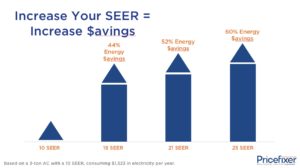
The Definition of SEER
What is SEER? The short and simple explanation of SEER is that it’s a number assigned to an AC unit indicating its energy efficiency. The higher the SEER number, the more energy efficient the system is, which is important because an energy-efficient unit will not only reduce your monthly utility bills, but will also reduce your carbon footprint, thereby benefitting the environment. Naturally, then, it would make sense to purchase an AC unit with the highest SEER rating available, right? Well, not necessarily. As we explain a little more about the SEER rating, you’ll understand why a high-rated SEER unit may not be the right one for you.
S-E-E-R – Breaking it down
SEER stands for “Seasonal Energy Efficiency Ratio.” The key word to remember in this acronym is “Seasonal,” as the SEER number is determined by measuring an AC unit’s efficiency as it operates over a period of time with varying degrees of temperature and humidity levels, which mimic a typical summer season for most areas in the U.S. This is typically referred to as the “cooling season.”
SEER ratings are calculated by measuring the amount of cooling provided (energy output, measured in BTU’s), during a cooling season and dividing it by the amount of energy consumed (energy input, measured in watts), over this same period of time. An AC unit that uses less energy to produce the same amount of cooling than another unit over the cooling season, operates more efficiently and will have a higher SEER number. Of course, the higher the SEER number, the more expensive the unit, but oftentimes the savings recouped from a more energy-efficient unit make up for the higher upfront cost. For example, if you replace a SEER 10 unit with a SEER 13 unit, then the same amount of cooling will be produced while using 30% less energy! That’s a 30% reduction in harmful emissions and a 30% reduction in your utility bill. If you have a unit with a SEER rating that’s less than 10, and you upgrade to a SEER 13, or higher, then the energy and cost savings will be even greater.
When shopping for a new AC unit, the SEER rating is an important piece of information that allows you to compare the energy efficiency of air conditioners and help determine an AC unit’s approximate annual operating costs.
SEER vs. EER
Oftentimes alongside the SEER rating, you will see an EER rating. EER stands for “Energy Efficiency Ratio” and is a number that measures an AC unit’s energy efficiency at a specific temperature, instead of over a period of time with different temperatures (hence, no “S” for seasonal). EER was created in 1975 by the Air Conditioning, Heating & Refrigeration Institute (AHRI) as a way of measuring the cooling efficiency of HVAC units. To determine the EER rating, the amount of cooling provided (energy output) is divided by the amount of energy consumed (energy input) while operating under a singular set of weather conditions, which is typically an outdoor temperature of 95°F, an indoor temperature of 80°F, and a humidity level around 50%.
Realizing that the EER rating doesn’t take into account certain variables, such as seasonal weather fluctuations and the resulting heat loss or gain that occurs when a system frequently cycles on and off, the SEER rating was developed in 1978 to more accurately gauge a unit’s efficiency during a typical summer season. The SEER rating, then, differs from an EER rating in that it is an average calculated over time; SEER is a measurement of an AC unit’s efficiency as it maintains a constant indoor temperature over the course of a cooling season with varying outdoor temperatures ranging from a low of 65°F to a high of 104°F with humidity levels ranging from 30% to 80%.
Just as with SEER ratings, a high EER rating indicates a more energy-efficient system and is a useful way to determine the efficiency of an AC unit when comparing across brands. However, the SEER number is a better indicator of an AC unit’s overall operational cost as it takes into account how well the unit works under a variety of weather conditions over the course of typical year. Just remember to always compare one unit’s EER to another’s EER, and SEER number to SEER number when looking at multiple units.
SEER by the Numbers (13/14 SEER, 16 SEER, 18 SEER, 21 SEER)
As previously mentioned, a SEER 10 unit replaced with a SEER 13 unit results in a 30% energy savings. What if you wanted to go even higher? Below is an example of the potential energy savings and cost savings of replacing a SEER 10 unit with a higher SEER-rated unit.
Based on a 3-ton AC with a SEER 10 rating that consumes around $1,323 in electricity per year:
- A SEER 18 unit will produce 44% in energy savings per year and consume around $735 in electricity per year.
- A SEER 21 unit will produce 52% in energy saving per year and consume around $630 in electricity per year.
- A SEER 25 unit will produce 60% in energy savings per year and consume around $529 in electricity per year.

What does SEER have to do with MPG?
It’s important to note that an AC unit’s SEER rating represents the maximum efficiency of that particular unit. This means that an AC unit with a SEER 22 rating can reach an efficiency level as high as 22, but may not always operate at a 22. So, just like Miles Per Gallon (MPG), which is used to measure the gas efficiency of a car, the higher the MPG rating, the more miles per gallon you can get out of it; but only when it’s being driven under ideal travel conditions (good weather, safe speeds, level ground, etc.). If, on the other hand, you drive your 36 MPG rated car like one of the characters from the Fast and the Furious, then your car’s average MPG number will be much lower, perhaps in the 20s.
There are things you can do to help your AC unit run at its most efficient rating, such as maintaining a regular temperature in your home, keeping the air filters clean, and checking for leaks in the ductwork.
Benefits and Regulation
Created and regulated by the Department of Energy in 2008, the SEER rating helps consumers cut down on energy consumption and costs while providing better cooling for their home. Also, by raising the minimum SEER rating across the U.S., the depletion of natural resources will be reduced as will the emission of harmful gases into the environment. It is required by law that all central air conditioning units be evaluated, rated, and assigned a SEER number by the manufacturer in accordance with efficiency tests stipulated by the U.S. Department of Energy.
FTC and the US Department of Energy
In 2015, the DOE established new minimum efficiency ratings for three different portions of the U.S. – the North, the South, and the Southwest. For new central air conditioners manufactured and sold in the warmer, southern regions, the minimum SEER was raised to 14. For northern regions, the minimum remains a SEER 13. The standard SEER breakdown across the nation is as follows:
SEER 13 minimum: Alaska, Colorado, Connecticut, Idaho, Illinois, Indiana, Iowa, Kansas, Maine, Massachusetts, Michigan, Minnesota, Missouri, Montana, New Hampshire, New Jersey, New York, North Dakota, Ohio, Oregon, Pennsylvania, Rhode Island, South Dakota, Utah, Vermont, Washington, West Virginia, Wisconsin and Wyoming
SEER 14 minimum: Alabama, Arizona, Arkansas, California, Delaware, Florida, Georgia, Hawaii, Kentucky, Louisiana, Maryland, Mississippi, North Carolina, Nevada, New Mexico, Oklahoma, South Carolina, Tennessee, Texas, and Virginia.
It is not required that consumers immediately upgrade to a more efficient unit, rather the minimum rating only applies to new units being manufactured and sold in the U.S. after January 2015.
Also, the Federal Trade Commission’s EnergyGuide label (the yellow “hang tag” attached to heating and cooling systems), will now display a range of numbers representing the lowest and highest SEER rating for split-system air conditioners, instead of a single rating.
Types of AC
Now that you know about SEER and EER ratings and how they relate to an AC unit’s efficiency, understanding the different types of air conditioning systems available will help you decide which option is the best one for your home.
Window Units: Also known as “room air conditioners,” this type of system contains all the necessary AC components (compressor, condenser, evaporator, and cooling coil) into a single box that is placed either in a window or wall of a room. Blowing cool air directly into a room, this type of system is effective for cooling small spaces and homes. Window units only have an EER rating.
Central Air Conditioners: Distributing cooled air via a system of ducts, Central AC systems work best for larger homes and buildings.The two most common types of Central Air Conditioning systems are split or packaged units.
Split systems: A split system has an indoor component, which includes the evaporator coil and blower, and an outdoor component, which includes the condenser coils, condensing fan, and the compressor housed in a metal case. This type of system is economical because it shares the ductwork used by the heating system.
Packaged units: A packaged unit is usually located outdoors and combines the evaporator coil, condenser, and compressor into a single cabinet. Air is drawn from the inside through ducts in the wall or roof and returned, cooled, to the inside of the house. Packaged units also typically include heating coils eliminating the need for a separate indoor furnace.
Ductless Mini-Split Systems: Ideal for houses with no ductwork, the mini-split system uses tubing to combine the outside compressor and condenser to indoor air-handling units, which are typically mounted high on a room’s interior wall and circulates the cooled air with a fan. Each room, however, will have its own air handler, much like a window unit, with the ability to cool a room to a temperature different from other surrounding rooms.
When determining the type of air conditioning system for your home, it’s important you choose a system that’s best fits the size of your home. A system that is too large or too small will not adequately cool or dehumidify your home.
Getting Another Bid
Now that you have a better understanding of how the SEER rating can affect your energy savings and reduce your monthly utility bill, it’s important to shop around to find the lowest-priced air conditioning system with your ideal SEER number. Don’t accept the first bid you come across – get another one, and another one still from a variety of AC retailers, including online retailers. You will be shocked at just how much money you can save by cutting out the “middle man” and ordering your new AC unit online. Check out these lowest-guaranteed prices here!